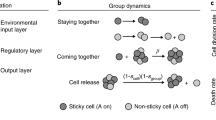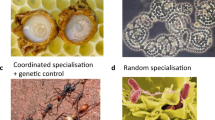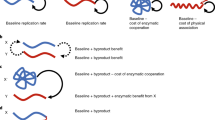Abstract
The social amoeba, Dictyostelium discoideum, is widely used as a simple model organism for multicellular development1,2, but its multicellular fruiting stage is really a society. Most of the time, D. discoideum lives as haploid, free-living, amoeboid cells that divide asexually. When starved, 104–105 of these cells aggregate into a slug. The anterior 20% of the slug altruistically differentiates into a non-viable stalk, supporting the remaining cells, most of which become viable spores3,4,5. If aggregating cells come from multiple clones, there should be selection for clones to exploit other clones by contributing less than their proportional share to the sterile stalk. Here we use microsatellite markers to show that different clones collected from a field population readily mix to form chimaeras. Half of the chimaeric mixtures show a clear cheater and victim. Thus, unlike the clonal and highly cooperative development of most multicellular organisms, the development of D. discoideum is partly competitive, with conflicts of interests among cells. These conflicts complicate the use of D. discoideum as a model for some aspects of development, but they make it highly attractive as a model system for social evolution.
This is a preview of subscription content, access via your institution
Access options
Subscribe to this journal
Receive 51 print issues and online access
$199.00 per year
only $3.90 per issue
Buy this article
- Purchase on Springer Link
- Instant access to full article PDF
Prices may be subject to local taxes which are calculated during checkout


Similar content being viewed by others
References
Maeda, Y., Inouye, K. & Takeuchi, I. (eds) Dictyostelium—A Model System for Cell and Developmental Biology (Universal Academy, Tokyo, 1997).
Gross, J. D. Developmental decisions in Dictyostelium discoideum. Microbiol. Rev. 58, 330–351 (1994).
Bonner, J. T. The Cellular Slime Molds (Princeton Univ. Press, Princeton, 1967).
Raper, K. B. The Dictyostelids (Princeton Univ. Press, Princeton, 1984).
Raper, K. B. Pseudoplasmodium formation and organization in Dictyostelium discoideum. Journal of the Elisha Mitchell Scientific Society 56, 241–282 (1940).
Williams, G. C. Adaptation and Natural Selection: A Critique of Some Current Evolutionary Thought (Princeton Univ. Press, Princeton, 1966).
Gadagkar, R. & Bonner, J. T. Social insects and social amoebae. J. Biosci. 19, 219–245 (1994).
Armstrong, D. P. Why don’t cellular slime molds cheat. J. Theor. Biol. 109, 271–283 (1984).
Buss, L. W. Somatic cell parasitism and the evolution of somatic tissue compatibility. Proc. Natl Acad. Sci. USA 79, 5337–5341 (1982).
Hilson, J. A., Kolmes, S. A. & Nellis, L. F. Fruiting body architecture, spore capsule contents, selfishness, and heterocytosis in the cellular slime mold, Dictyostelium discoideum. Ethol. Ecol. Evol. 6, 529–535 (1994).
Wilson, D. S. & Sober, E. Reviving the superorganism. J. Theor. Biol. 136, 337–356 (1989).
Kessin, R. H. in Dictyostelium—A Model System for Cell and Developmental Biology (eds Maeda, Y., Inouye, K. & Takeuchi, I.) 3–13 (Universal Academy, Tokyo, 1997).
Atzmony, D., Zahavi, A. & Nanjundiah, V. Altruistic behaviour in Dictyostelium discoideum explained on the basis of individual selection. Curr. Sci. 72, 142–145 (1997).
Huss, M. J. Dispersal of cellular slime moulds by two soil invertebrates. Mycologia 81, 677–682 (1989).
Hamilton, W. D. The genetical evolution of social behaviour. I, II. J. Theor. Biol. 7, 1–52 (1964).
Francis, D. & Eisenberg, R. Genetic structure of a natural population of Dictyostelium discoideum, a cellular slime mold. Mol. Ecol. 2, 385–391 (1993).
Ketcham, R. B. & Eisenberg, R. M. Clonal diversity in populations of Polysphondylium pallidum, a cellular slime mold. Ecology 70, 1425–1433 (1989).
Grosberg, R. K. The evolution of allorecognition specificity in clonal invertebrates. Q. Rev. Biol. 63, 377–412 (1988).
Filosa, M. F. Heterocytosis in cellular slime molds. Am. Nat. 96, 79–91 (1962).
Houle, J., Balthazar, J. & West, C. M. A glycosylation mutation affects cell fate in chimeras of Dictyostelium discoideum. Proc. Natl. Acad. Sci. USA 86, 3679–3683 (1989).
Ennis, H. L., Dao, D. N., Pukatzki, S. U. & Kessin, R. H. Dictyostelium amoebae lacking an F-box protein form spores rather than stalk in chimeras with wild type. Proc. Natl Acad. Sci. USA 97, 3292–3297 (2000).
Velicer, G. J., Kroos, L. & Lenski, R. E. Developmental cheating in the social bacterium Myxococcus xanthus. Nature 404, 598–601 (2000).
Stoner, D. S., Rinkevich, B. & Weissman, I. L. Heritable germ and somatic cell lineage competitions in chimeric colonial protochordates. Proc. Natl Acad. Sci. USA 96, 9148–9153 (1999).
Grosberg, R. K. & Quinn, J. F. The genetic control and consequences of kin recognition by the larvae of a colonial marine invertebrate. Nature 322, 456–459 (1986).
Dawkins, R. & Krebs, J. R. in Behavioural Ecology: An Evolutionary Approach 2nd edn (eds Krebs, J. R. & Davies, N. B.) 282–309 (Blackwell, Oxford, 1978).
Elgar, M. A. & Nash, D. R. Sexual cannibalism in the garden spider Araneus diadematus. Anim. Behav. 36, 1511–1517 (1988).
Queller, D. C. & Strassmann, J. E. Kin selection and social insects. Bioscience 48, 165–175 (1998).
Loomis, W. F. Four Billion Years; An Essay on the Evolution of Genes and Organisms (Sinauer, Sunderland, Massachusetts, 1988).
Kay, R. R. & Williams, J. G. The Dictyostelium genome project—an invitation to species hopping. Trends Genet. 15, 294–297 (1999).
Holm, S. A simple sequentially rejective multiple test procedure. Scand. J. Statist. 6, 65–70 (1979).
Acknowledgements
We thank R. Gomer for advice and training; D. Welker for supplying the clones; J. Keay, W. Castle, S. Reddy and J. Damon for assistance with laboratory work; and D. Rozen, R. Kessin, G. Velicer and J. Bonner for comments on the manuscript. This work was supported in part by the US National Science Foundation.
Author information
Authors and Affiliations
Corresponding author
Rights and permissions
About this article
Cite this article
Strassmann, J., Zhu, Y. & Queller, D. Altruism and social cheating in the social amoeba Dictyostelium discoideum. Nature 408, 965–967 (2000). https://doi.org/10.1038/35050087
Received:
Accepted:
Issue Date:
DOI: https://doi.org/10.1038/35050087
This article is cited by
-
The evolution of mechanisms to produce phenotypic heterogeneity in microorganisms
Nature Communications (2022)
-
Ten recent insights for our understanding of cooperation
Nature Ecology & Evolution (2021)
-
Do Somatic Cells Really Sacrifice Themselves? Why an Appeal to Coercion May be a Helpful Strategy in Explaining the Evolution of Multicellularity
Biological Theory (2021)
-
Why have aggregative multicellular organisms stayed simple?
Current Genetics (2021)
Comments
By submitting a comment you agree to abide by our Terms and Community Guidelines. If you find something abusive or that does not comply with our terms or guidelines please flag it as inappropriate.



